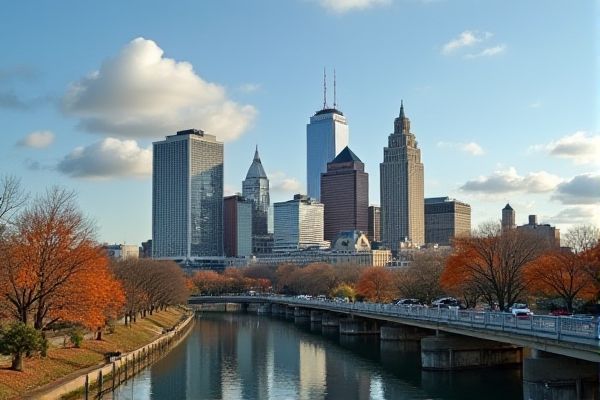
What to know as new resident in Illinois: Weather variations require wardrobe versatility. High property taxes statewide. Public transportation options extensive in cities. Explore local cuisine, especially deep-dish pizza. State income tax rate flat. Cultural diversity across neighborhoods. Illinois state laws enforcement strict. Agriculture major part of economy. Education system includes numerous universities. Abundant outdoor recreation opportunities available.
Weather variations require wardrobe versatility.
As a new resident in Illinois, you need to be prepared for significant weather variations, requiring a versatile wardrobe that includes layers for spring and fall, light to heavy clothing for summer, and warm, layered clothing for winter. It is essential to equip yourself with items such as coats, gloves, hats, and boots to handle the cold and snowy conditions. Discover more tips about dressing appropriately by visiting the What to Wear in Chicago All Year guide, which offers comprehensive advice tailored to every season in the Windy City.
High property taxes statewide.
As a new resident in Illinois, you should be aware that the state has the second-highest property tax rate in the U.S., with an average effective tax rate of about 2% of a home's value. This translates to a typical annual property tax bill of around $5,055, which is significantly higher than the national average. This hefty tax burden has been highlighted by the Illinois Policy Institute, noting that these rates have been increasing faster than inflation.
Public transportation options extensive in cities.
In Illinois, particularly in the North Central region and Chicago, public transportation options are extensive, including various bus systems like Lee-Ogle Transportation System, Kendall Area Transit, and Greyhound routes. Additionally, commuter rail services, such as Metra and Amtrak, are available, alongside the comprehensive Chicago Transit Authority (CTA) system, which features 'L' trains and buses.
Explore local cuisine, especially deep-dish pizza.
As a new resident in Illinois, you should know that Deep-Dish Pizza is an iconic local dish, characterized by a thick, buttery crust, loads of mozzarella, and a layer of tangy tomato sauce on top. Popular spots for deep-dish pizza include Uno Pizzeria & Grill, Lou Malnati's, Gino's East, and Giordano's. For more insights into the culinary delights of the Windy City, be sure to check out the various offerings detailed on the Choose Chicago website. This guide will ensure you don't miss out on the city's most delectable fare.
State income tax rate flat.
Illinois has a flat income tax rate of 4.95 percent, applicable to all residents regardless of their income level, with no tax brackets or varying rates based on income. For more detailed information on state taxes, visit the AARP State Taxes Guide, which provides comprehensive resources and insights regarding taxation in Illinois and how it might affect you.
Cultural diversity across neighborhoods.
In Illinois, particularly in Chicago, cultural diversity is vibrant across various neighborhoods, such as Lincoln Square (German), Greek Town (Greek), Pilsen (Mexican), Chinatown (Chinese), Polish Downtown (Polish), and Little Italy (Italian), each offering unique cultural experiences, cuisine, and historical landmarks. The exploration of these areas can be an enriching experience for both locals and tourists alike. Discover more about these fascinating places and their unique offerings by visiting the Ethnic Neighborhoods in Chicago website, which provides insights into the remarkable blend of cultures that make Chicago a diverse and dynamic city.
Illinois state laws enforcement strict.
In Illinois, state laws enforce strict regulations on gun ownership and use, including background checks for ghost gun parts, prohibition of high-capacity magazines, and microstamping for new handguns. Additionally, the state has implemented police reforms such as restrictions on use of force, mandatory body cameras by 2025, and enhanced accountability for police misconduct. For a deeper understanding of these measures, you can explore the rankings and detailed analysis at EverytownResearch.
Agriculture major part of economy.
Agriculture is a pivotal sector in Illinois's economy, with the state ranking second in corn production and first in soybean production nationally. It generates over $426 billion in economic output, supports nearly 1.9 million jobs, and accounts for about 1 out of 10 dollars generated in the state. To delve deeper into how Agriculture Fuels Illinois's Economy, the impact of this sector is substantial, encompassing job creation and significant economic contributions.
Education system includes numerous universities.
The University of Illinois System, the state's largest system of higher education, comprises three main campuses in Urbana-Champaign, Chicago, and Springfield, offering hundreds of undergraduate, graduate, and professional programs. It also includes regional campuses, research facilities, and Extension offices, and is a significant driver of economic growth and innovation in Illinois.
Abundant outdoor recreation opportunities available.
Illinois offers a vast array of outdoor recreation opportunities, including 64 state parks, 289,000 acres of protected national forest, seven scenic byways, and numerous lakes, rivers, and wetlands, providing endless options for hiking, biking, fishing, boating, and wildlife watching across different regions of the state. From Starved Rock State Park and Shawnee National Forest to Pere Marquette State Park and the Illinois Route 66 Trail, there are diverse adventures available for all interests and skill levels. Discover more about the incredible experiences awaiting you in this beautiful state by visiting Outside Online and explore the multitude of options it has to offer.
